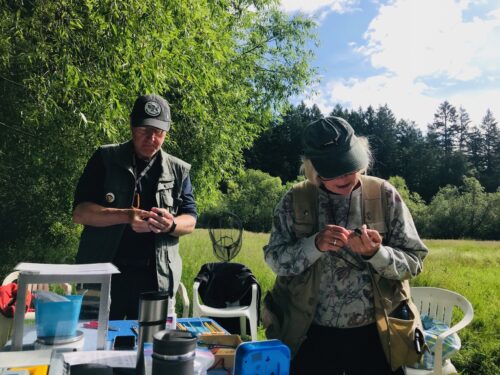MAPS
Monitoring Avian Productivity and Survivorship
The Monitoring Avian Productivity and Survivorship (MAPS) program is managed by the Institute for Bird Populations (IBP) in California to assess and monitor the vital rates and population dynamics of North American landbirds. Each summer dedicated volunteers operate bird-banding stations to collect data on individual "birds-in-the-hand" representing over 200 species.
The MAPS program utilizes constant-effort mist netting and banding at a continent-wide network of monitoring stations. Analyses of MAPS data provide critical information relating to the ecology, conservation, and management of North American landbird populations and the factors responsible for changes in their populations.
Read more about MAPS Program from IBP
IBP MAPS Chat: The Institute for Bird Populations maintains an archive of the MAPS Chat newsletters with many useful articles for banders. Check out the spring 2014 issue which features an article on RPBO's MAPS stations!
MAPS at RPBO
RPBO currently operates two MAPS stations - one at Witty’s Lagoon Regional Park since 2009, and a second site on the Power to Be property on Prospect Lake since 2021.
MAPS is our first songbird banding project of the year, operating between May and August (MAPS periods 4 to 10). We visit each site once every 10 days for a total of 7 visits per site per year. The timing of MAPS in the late spring and early summer enables stations to monitor breeding birds and their young in each area and track their survival rate. We not only band birds, but also record all the species seen and heard, noting their breeding status using specific codes.
A Brief History
In 2003 Rocky Point Bird Observatory began operating two MAPS stations on Department of National Defense properties, one at Rocky Point in Metchosin, the other at Royal Roads University in Colwood. Royal Roads had not proven to be a terribly productive site so, in 2009, we sought an alternate location. A suitable site was found at Witty's Lagoon Regional Park in Metchosin and MAPS monitoring was conducted at this location for the first time in 2009. In 2011, access to the Rocky Point site was denied and we sought an alternate location which we found at Madrona Farms in the Blenkinsop Valley. This site was used up until the 2019 season. During the COVID pandemic we only operated a single MAPS station (Witty's Lagoon) and in 2021 the Power to Be site at Prospect Lake was added.
 .
. 
Photo: Red-breasted Sapsucker. Photo: Mark Byrne and Jannaca Chick at Power To Be MAPS station .
Visiting our MAPS Banding Station
To see some birds up close and watch our banders in action, you can schedule a visit to our WItty's Lagoon monitoring station on any of our scheduled mornings. Although the banding station is located on public CRD land, it is recommended that visits be coordinated through the Bander in Charge (BIC). This helps ensure you receive accurate directions to the station and allows the team to prepare for the expected number of visitors during any given session. The BIC can be reached at maps@rpbo.org.
Please view the available dates and times here.
RPBO & Power To Be
Power To Be is a non-profit organization that provides access to nature and various outdoor activities for youth, families, and adults living with cognitive, physical, financial, and social barriers. In 2023, we started to arrange for PTOB groups to visit our banding station and learn more about birds and bird banding.
On June 23, 2024, our MAPS banding crew, including Jannaca Chick, Robyn Byrne, Mark Byrne and Ann Scarfe, were at the Power To Be site on Prospect Lake, Victoria. That day Altitude Sports was making a film about the amazing work done by Power To Be, a non-profit organization that creates access to nature for youth, families, and adults living with cognitive, physical, financial and social barriers. They included our MAPS banding as part of their film! Watch this video to see what Power To Be is all about, the RPBO banding crew in action, and how we include PTB groups. Watch the video.
For more information on Power to Be, please visit their website: https://powertobe.ca/prospect-lake/
RPBO MAPS Project Reports
Annual reports from our MAPS projects for the following years and monitoring stations are available here as PDFs:
RPBO & SaP Project
We will also be collaborating with the SAP Project out of Colorado State University. Every spring, millions of songbirds leave their wintering grounds and migrate north to their breeding range. These birds provide a variety of benefits to nature and people, such as pest control and seed dispersal, as well as aesthetic beauty and recreational opportunities. Another service that these birds may provide is pollination: however, the nature and frequency of pollination by North American migrants has not been systematically investigated. The pollen DNA will show what flowers the songbird has foraged in, giving an idea of the plants possibly pollinated by songbirds, and subsequently plants of interest for protecting declining bird species. We will be collecting pollen from the hummingbirds and warblers that we band at both sites to contribute to this interesting study.
For more information on the SAP Project, please visit their website: https://carolyncoyle.wixsite.com/sapproject

